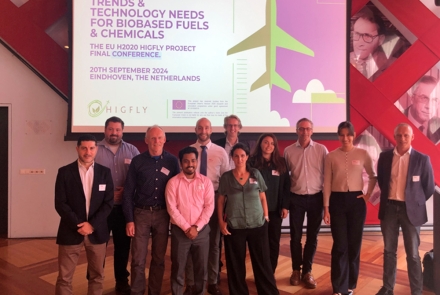Biorefinery Pre-Treatment Integration to the HIGFLY Process
The HIGFLY process uses C5 sugars that can be produced in biorefineries using lignocellulosic biomass as a feedstock which contain three main components, cellulose, hemicellulose and lignin. The polymeric hemicellulose fraction contains various types of monomers, of which C5 sugars like xylose and arabinose are the most applicable for the HIGFLY process as they are suitable for furfural production.
When the feedstock reaches the biorefinery there are three additional stages as seen in Figure 1 below, that lead to the production of C5 sugars which then can be inputted to the HIGFLY process.

Most commonly, the pre-treatment splits the lignocellulose into its fractions whereby the C5 and C6 sugars are either separated or delivered as a mixture. There are several pre-treatment processes (i.e., chemical, combined chemical and mechanical, biological pre-treatment, among others) used in biorefineries which makes it very important that the most appropriate processes are chosen to be integrated into the HIGFLY process based upon their technical feasibility, operational scale and available data.
Within the various pretreatment pathways available today, there are several pre-treatment options considered relevant to HIGFLY and its objectives. Weak acid, steam explosion and organosolv are some of the technologies considered to be potentially compatible with the HIGFLY process.
Testing and literature reviews of the biomass pre-treatments are ongoing, however, it is clear that for pre-treatment selection, the pathway must provide a sufficiently high C5 sugars hydrolysis yield to mitigate sugar losses upstream during the HIGFLY process.
Once the technical feasibility of the pre-treatment processes has been confirmed and the optimal methods established, biorefineries need to be sourced that have successfully conducted these processes in order to determine the potential size of the plants, their current state of production and the type of biomass used.
Biomass selection is obviously an important aspect of the HIGFLY process and, although, the project aims at designing technologies flexible enough to treat a diverse range of biomass, it is necessary that they contain a sufficiently high ratio of C5 to C6 sugars, as commonly found in hardwoods, herbaceous biomasses and agricultural residues. In addition, availability, techno-economic, environmental, sustainability and social impact aspects of potential biomasses must be assessed, not only to ensure that the HIGFLY products and processes have a viable market uptake potential, but also that they are in line with sustainability criteria in EU legislation such as RED II and CORSIA.
Choosing the appropriate biorefinery concepts and biomass feedstocks are the foundation from which the HIGFLY project will develop efficient and scalable reactor and separation state-of-the-art technologies aimed at producing the next generation of sustainable aviation fuels and novel, robust catalysts and sustainable solvents for the renewable energy sector.







